Trees Birds Mammals Fish Amphibians Reptiles
Wild Algarve
Bookshop
Caloboletus radicans Pers. - Rooting Bolete
Phylum: Basidiomycota - Class: Agaricomycetes - Order: Boletales - Family: Boletaceae
Distribution - Taxonomic History- Etymology - Identification - Culinary Notes - Reference Sources
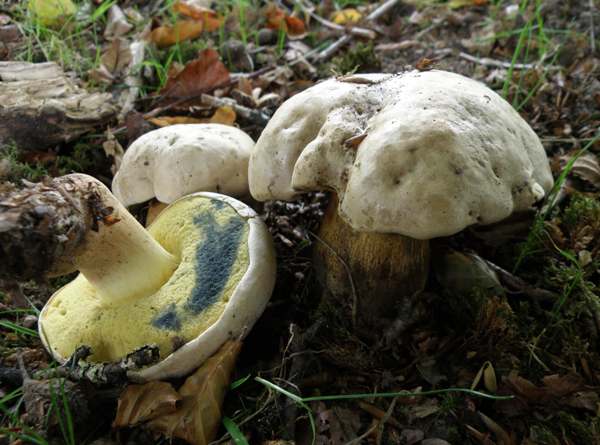
Often seen on compacted roadside verges, the Rooting Bolete, Caloboletus radicans, looks as though it has been pelted with fast-flying chippings thrown out from the tyres of passing traffic.
The pale grey caps are usually dented and misshapen, particularly in more mature specimens. It comes as quite a surprise, therefore, when you look underneath the cap and discover beautiful yellow pores that turn pale to mid blue if you touch them.
Distribution
Found throughout much of Britain and Ireland, although mostly confined to the southern parts, Boletus radicans occurs also in most European countries, although in Scandinavia it is a very rare find. The specimens pictured above were seen in a shallow ditch under roadside oaks in Hampshire, England.
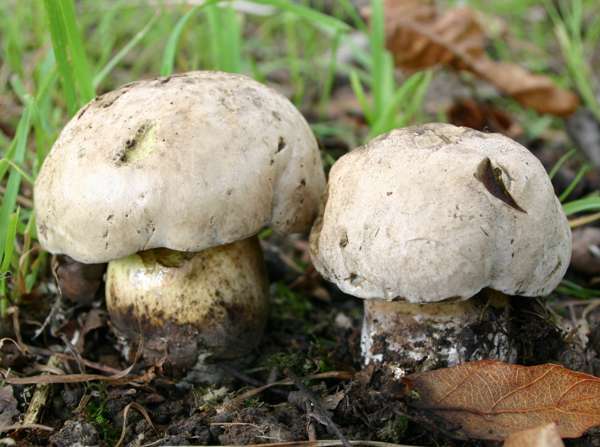
Taxonomic history
Caloboletus radicans was first named and described scientifically in 1801 by Christiaan Hendrik Persoon, who called it Boletus radicans. In 2014 Italian mycologist Alfredo Vizzini transferred this bolete to the new genus Caloboletus based on new DNA findings; its name then became Caloboletus radicans. Among its synonyms are Boletus radicans Pers., Boletus albidus Roques., and Boletus pachypus Fr.
Etymology
The generic name Caloletus comes from the Greekcalo- is derived from Greek Calo- meaning pretty, and -bolos meaning 'lump of clay'. The specific epithet radicans means 'rooting', and some but not all fruitbodies display a rooting characteristic, with stout mycelial threads attached to the stem base and extending for some distance into the soil.
Like other boletes found in Britain and Ireland, Caloboletus radicans is an ectomycorrhizal fungus, which means that it forms symbiotic relationships with the root systems of trees. In the case of the Rooting Bolete it has been found to associate mainly with oak trees and less often with beeches.
Identification guide
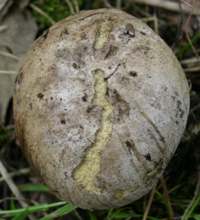 |
Cap
5 to 20cm across, often irregularly lobed, the caps of the Rooting Bolete are various shades of smoky-grey, gradually becoming dull buff. The central region tends to become cracked at maturity. Cap flesh is pale yellow and turns light blue when cut and exposed to air. |
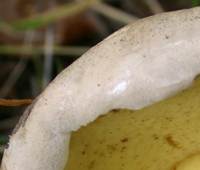 |
Tubes and Pores
The yellow tubes of Caloboletus radicans terminate in tiny yellow
pores that turn pale blue when cut or bruised. |
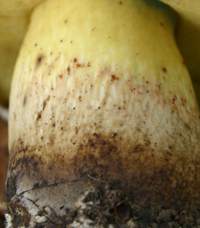 |
Stem
7 to 14cm tall and 3 to 5cm in diameter, stems of Caloboletus radicans are very variable in form, occasionally swollen but sometimes cylindrical and clavate at the base; yellow, covered with a fine reticulum and sometimes with a reddish zone near to the base. |
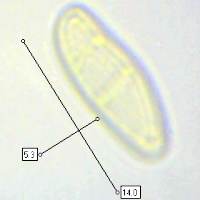 |
Spores
10-15 x 4-6μm, subfusiform (narrowly spindle-shaped).
Spore print
Olivaceous brown. |
Odour/taste |
Bitter taste; strong and unpleasant fungal smell. |
Habitat & Ecological role |
Mainly on alkaline or neutral soil beneath oak trees and occasionally with beeches. This species is also known to form mycorrhizal relationships with Rockrose (Helianthemun species). |
Season |
Summer and autumn. |
Similar species |
Suillellus luridus has a
darker cap and orange flesh in the stem base; it blues instantly when
cut.
Rubroboletus satanas has a white cap and orange or red pores when mature; its flesh turns pale blue when cut and then fades back to its original pallid colour.
Caloboletus calopus has a red reticulate stem base. |
Culinary Notes
White-capped boletes are not generally edible, and Caloboletus radicans is no exception: it has a very strong and bitter taste.
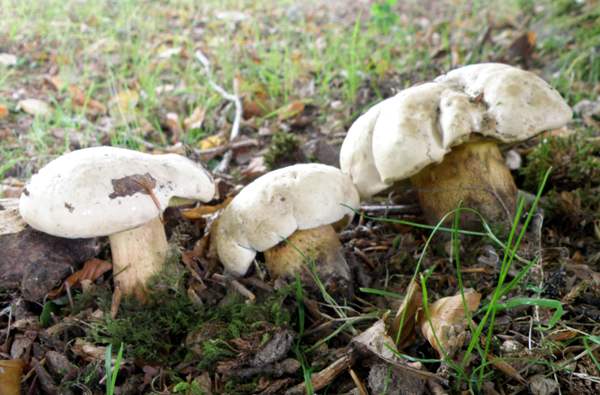
Reference Sources
Fascinated by Fungi, 2nd Edition, Pat O'Reilly 2016, reprinted by Coch-y-bonddu Books in 2022.
British Boletes, with keys to species, Geoffrey Kibby (self published) 3rd Edition 2012
Knudsen, H. & Vesterholt, J. [eds.]. 2008. Funga Nordica. Nordsvamp, Kopenhagen.
Roy Watling & Hills, A.E. 2005. Boletes and their allies (revised and enlarged edition), - in: Henderson, D.M., Orton, P.D. & Watling, R. [eds]. British Fungus Flora. Agarics and boleti. Vol. 1. Royal Botanic Garden, Edinburgh.
BMS List of English Names for Fungi
Dictionary of the Fungi; Paul M. Kirk, Paul F. Cannon, David W. Minter and J. A. Stalpers; CABI, 2008
Taxonomic history and synonym information on these pages is drawn from many sources but in particular from the British Mycological Society's GB Checklist of Fungi.
Acknowledgements
This page includes pictures kindly contributed by Simon Harding.
Top of page...
Fascinated by Fungi. Back by popular demand, Pat O'Reilly's best-selling 450-page hardback book is available now. The latest second edition was republished with a sparkling new cover design in September 2022 by Coch-y-Bonddu Books. Full details and copies are available from the publisher's online bookshop...